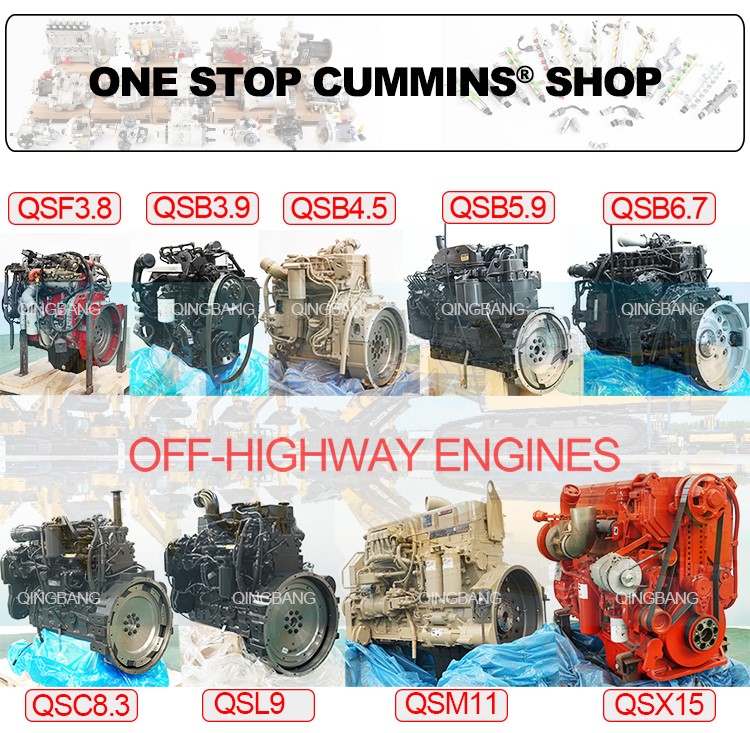
Cummins OFF HIGHWAY Engine Complete
Cummins QSF3.8 (TIER 4 FINAL/STAGE IV)
74 – 130 horsepower, 55 - 97 kW, 376 - 488 N•m, 277 - 360 lb-ft, Tier 4 Final / Stage IV
Applications- Agriculture, Construction, Mining Engines, Oil and Gas Engines, Rail Engines, Well Servicing
From 100-130 hp, the QSF3.8 is paired with a Diesel Oxidation Catalyst and Selective Catalytic Reduction (DOC-SCR) system designed by Cummins Emission Solutions (CES). Cummins SCR enables oxides of nitrogen (NOx) conversion to take place at lower exhaust temperatures. CES has manufactured over 1 million SCR systems – and has more experience with this technology than any other company. The Cummins SCR system features a decomposition tube designed to enable more effective mixing of the Diesel Exhaust Fluid (DEF) ahead of the catalyst. Additionally, for certain applications, the QSF3.8 can be paired with an SCR-only aftertreatment system.
Cummins QSB FOR AGRICULTURE (TIER 2)
horsepower 110 - 275 hp, Torque 82 - 205 kW, 305 - 730 lb-ft, 414 - 990 N•m, Tier 2 / Stage II
Ratings range from 110-275 hp, with both charge air cooled and turbocharged versions that deliver strong performance at every start. A low-maintenance filter assembly is just one of many standard features that minimize downtime for maintenance. Among the many options that let you customize your QSB are packages that reduce the overall noise level by as much as 4 dBA.
Applications- Agriculture
Maintenance Intervals
QSB engines are designed to run up to 250 hours/6 months for turbocharged engines and 500 hours/6 months for charge air-cooled engines between scheduled maintenance stops.
QSB3.9
In-Line, 4-Cylinder, 238 cu in3.9 liters displacement, Advertised Horsepower 120-130 hp, 89-97 kW, Peak Torque 350-355 lb-ft, 475-481 N•m
QSB4.5
In-Line, 4-Cylinder, 275 cu in4.5 liters displacement, Advertised Horsepower 110hp, 82 kW, Peak Torque 305 lb-ft, 414N•m
QSB5.9
In-Line, 6-Cylinder, 359 cu in5.9 liters displacement, Advertised Horsepower 130-275hp, 97-205 kW, Peak Torque 400-730 lb-ft, 542-990N•m
QSB6.7 Cummins
QSB6.7 For Tier 4 Final/Stage IV.
QSB6.7 engines range from 146-310 hp (109-231 kW) for Tier 4 Final. They have the same heat rejection as the Tier 4 Interim engines, so there is minimal, if any, impact on the cooling package. The QSB6.7 is one of the most popular and versatile engines ever built by Cummins.
This engine is used in every type of construction equipment, including excavators, cranes, wheel loaders, compactors, air compressors and material-handling equipment such as heavy forklifts and container-handling trucks. It is commonly found in agricultural tractors and sprayers, as well as chippers and feller bunchers in the logging market.
All of the performance upgrades from Tier 4 Interim have been incorporated into the Tier 4 Final engines, and we’re maximizing torque output, reaching 760 lb-ft (1030 N•m) on the QSB6.7.
QSC (TIER 3)
205-305 horsepower, 153-227 kW, 915-1383 N•m, 675-1020 lb-ft, Tier 3/ Stage IIIA
Applications- Agriculture, Construction, Marine Engines
The QSC features a 24-valve cylinder head, a High Pressure Common Rail (HPCR) fuel system and robust electronic controls that operate in complete orchestration to make a completely programmable, highly durable, highly fuel-efficient power plant. With one of the highest power-to-weight ratios and lowest cost of operation of any engine in its class. And ratings that range from 215-305 hp (160-227 kW) to deliver the power and the versatility you need to match your equipment.
QSL9 (TIER 4 FINAL/STAGE IV)
Clearly Ahead. Cummins QSL9 Engine For Tier 4 Final/Stage IV.
250-400 horsepower, 186-298 kW, 1627-1627 N•m, 1200-1200 lb-ft, Tier 4 Final / Stage IV
Applications- Agriculture, Construction, Mining Engines, Oil and Gas Engines, Rail Engines, Well Servicing
QSL9 engines are rated at 250-400 hp (186-298 kW) for Tier 4 Final. It has the same heat rejection as the Tier 4 Interim engines, so there is minimal, if any, impact on the cooling package. The QSL9 combines very high strength with a compact footprint, for one of the best power-to-weight ratios in its class.
This engine is used in every type of construction equipment, including excavators, cranes, wheel loaders, compactors, air compressors and material-handling equipment such as heavy forklifts and container-handling trucks. It is commonly found in agricultural tractors and sprayers, as well as chippers and feller bunchers in the logging market.
All of the performance upgrades from Tier 4 Interim have been incorporated into the Tier 4 Final engines, and we’re maximizing torque output, reaching 1200 lb-ft (1627 N•m) for the QSL9.
QSM11 (Tier 2, Tier 3)
290-400 horsepower, 216-298 kW, 1424-1898 N•m, 1050-1400 lb-ft,
Application-Agriculture, Oil and Gas Engines, Rail Engines
——For construction machinery
The QSM11-C fully electronically controlled engine is Cummins' flagship product for off-highway use, with a displacement of 10.8 liters and a power coverage of 250-400 horsepower, enjoying a high reputation in the global construction machinery field. The engine has excellent reliability, durability, fuel economy and safety, etc., and is widely used in rotary drilling rigs, truck cranes/crawlers, mining vehicles, oil field equipment, port reach stackers, wheel loaders, rail cars and other fields of construction machinery.
- For generator sets
The QSM11-G fully electronically controlled engine control system does not need to be equipped with the electronic fuel control governor (including speed sensor, governor control device, actuator and other installation parts) required by the mechanical generator set, which greatly simplifies the matching requirements. The most commonly used generator set controllers in China are perfectly combined, with five core engine technologies (filter system, fuel system, electronic control system, turbocharger system, combustion optimization system), helping generator set products to achieve economical and dynamic performance and the perfect combination of emission performance.
QSX15 (TIER 4 FINAL/STAGE IV)
450-675 horsepower, 336-503 kW, 2237-2779 N•m, 1650-2050 lb-ft, Tier 4 Final / Stage IV
Applications- Agriculture, Construction, Mining Engines, Oil and Gas Engines, Rail Engines, Drilling, Well Servicing
Better Performance. Where You Need it Most.
Whether you are manufacturing a large excavator, wheel loader, grader, rock drill or compressor, the QSX15 is engineered to deliver the economical, reliable power and performance that you expect from a Cummins engine. In fact, the QSX15 for Tier 4 Final offers ratings that are capable of achieving over a 50 percent increase in torque while at the same time getting better fuel economy.











